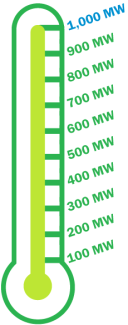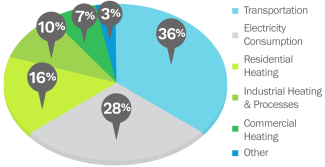RI in the Fight Against Climate Change: A Snapshot
Rhode Island is working to combat climate change on many fronts, and this dashboard is designed to highlight a handful of key metrics.
Last Updated October 2021
Clean Energy


100%
toward the goal of increasing RI's clean energy tenfold by 2020
As of May 31, 2021, the state has counted approximately 1,003 MW of clean energy generation capacity. Of that 1,003 MW total, 430 MW is offshore wind, 385 MW is solar, 144 MW is onshore wind, 35 MW is landfill gas/anaerobic digestion, and 9 MW is small hydroelectric power.
WHY IT MATTERS
A 400MW offshore wind farm can produce approximately one-quarter of all the electricity used by Rhode Islanders annually – without contributing to climate change through greenhouse gas emissions.
Learn More
Energy Efficiency


4.8
From 2007-2020, energy efficiency measures have saved electric power equal to that generated by 4.8 power plants. From 2008-2020, the greenhouse gas emissions prevented by RI’s natural gas efficiency programs are equal to taking 346,789 passenger vehicles off the road for one year.
Becoming more energy efficient not only cuts down on our energy bills, but it also reduces the amount of new energy infrastructure (poles, wires, powerplants and substations) needed to keep up with demand. This lowers costs for everyone connected to the grid. Rhode Island has long encouraged investments in energy efficiency, which is the most affordable way to reduce our greenhouse gas emissions. The Ocean State currently ranks third in the country for its comprehensive energy efficiency programs.
WHY IT MATTERS
There are lots of ways to become more energy efficient. You can install LED light bulbs, reinsulate your home, invest in energy star appliances and smart controls such as Wi-Fi thermostats. Schedule a free energy audit for your home or business to find out what programs may be available to help pay for your energy efficiency upgrades. Call 1-888-633-7947 for info.
Green Jobs


16,348
green jobs - the clean energy economy has grown by 77.3% since 2014
A clean energy job is any position, either full or part time, that focuses on renewable energy or energy efficiency work. These include solar technicians, wind turbine engineers, oceanographers, HVAC installers, and many others. Rhode Island has a goal to achieve 20,000 clean energy jobs. See our clean jobs infographic.
WHY IT MATTERS
Fighting climate change is good for the economy. Energy efficiency jobs make up the largest sector of the clean energy economy, with efficient heating and cooling representing the largest rate of growth.
Clean Cars


867%
Electric vehicles in Rhode Island have increased 867% from 2015 to October 2021. There are now 4,292 electric vehicles in Rhode Island. 51% of active electric vehicle registrations in Rhode Island are battery electric vehicles (BEVs) and 49% are plug-in hybrid electric vehicles (PHEVs).
There are three main types of electrified vehicles: electric vehicles, plug-in hybrid vehicles, and hybrid electric vehicles. Electric Vehicles (EVs) utilize electricity as their primary fuel source. EVs store their electrical energy in a large battery used to power the motor. Charging an EV is like charging a cell phone. Plug-In hybrid vehicles (PHEVs) use electricity to improve upon the efficiency of conventionally-fueled vehicles. When the battery runs out, PHEVs switch over to gasoline. Hybrid electric vehicles (HEVs) combine at least one electric motor with a gasoline engine to move the car, and its system recaptures energy via braking. RI is incentivizing the installation of EV charging stations in public places and working on transitioning the RIPTA fleet to electric buses. Publicly accessible EV charging stations are located throughout Rhode Island, with more being added each month. Locate a charging station along your commute.
WHY IT MATTERS
Electric vehicles (EVs) are powered by electricity, which as an energy source is cleaner than gas. They produce less pollution than a conventional gas-powered vehicle. Reduced harmful tail-pipe pollutants is good news for our health; better air quality will lead to fewer health problems and costs caused by air pollution.
Protected Land


9,030
acres of land have been protected by the state since 2010. This represents over a 10% increase in total land protected by state programs over the last 10 years.
The Open Space Grant program managed by Rhode Island Department of Environmental Management supports land protection and conservation efforts of local communities and non-profits. Since 1985, over 10,000 acres of land have been protected in Rhode Island. A cohesive network of protected lands and habitat have economic, health, and recreational benefits for communities. These important grant programs are supported by state bonds called "Green Economy and Clean Water Bonds," which invest in water quality, land cleanup, farmland, recreational facilities, and open space (among other things) to ensure our state remains a wonderful place to live, visit, and raise a family.
WHY IT MATTERS
Farms, forests, and open space filter and clean our water, provide recreational opportunities, and support our agricultural and tourism economies. They also cool our cities by blocking and absorbing sunlight and help fight climate change by storing carbon dioxide.
Resilient Communities


38/39
municipalities have approved Hazard Mitigation Plans to prepare their communities for the impacts of climate change. Additionally, 20 out of 39 communities are participating in the Resilient Rhody: Municipal Resilience Program to identify priority projects to further prepare their communities for climate change.
Hazard Mitigation Plans provide comprehensive guidance to prepare for natural hazards and climate change. The Municipal Resilience Program (MRP) provides direct support to cities and towns to complete a municipal-driven process that will bring together climate change information and local knowledge to identify top hazards, current challenges, and community strengths. After completing the planning process, participating municipalities can apply for funding to implement identified projects. The 2021 cohort of communities is: Cumberland, East Providence, Jamestown, New Shoreham, North Kingstown and Providence.
WHY IT MATTERS
Here’s one of many examples. The Block Island landfill (closed in 1990) is subject to severe coastal erosion. Storms, including Superstorm Sandy, cut away at the seaward slope and large amounts of debris washed into the ocean. Subsequent storms exacerbated water quality and public safety concerns. The Block Island Landfill Slope Repair Project pulled back the ocean facing slope of the landfill and created a strong stone revetment while also incorporating beach grass for stabilization.
Reduced Emissions


6%
RI's 2017 greenhouse (GHG) emissions are estimated at 11.74 MMTCO2e (in RI's most recent GHG Emissions Inventory) which is a 6% reduction below 1990 levels. RI's 'Act on Climate' sets enforceable targets to reduce emissions ten percent (10%) below 1990 levels by 2020, with ultimately reaching net-zero emissions by 2050.
Rhode Island completes a GHG inventory annually, with a more robust inventory completed every 3 years. It covers emissions by sector, including transportation, electricity consumption, residential heating, industrial heating and processes and commercial heating. In 2016, Rhode Island completed a plan which demonstrates that widespread adoption of clean energy technologies and practices are necessary to meet the Resilient RI emission reduction targets.
WHY IT MATTERS
When we burn fossil fuels for energy, we add more and more carbon dioxide into the atmosphere. This buildup acts like a blanket that traps heat. Increases in heat-trapping-gases (e.g. carbon dioxide) lead to many adverse effects, such as extreme storms, rising temperatures, and rising sea levels. Rhode Island is committed to the Paris Climate Accords, an agreement to address climate change by reducing human-induced heat trapping gases. RI completed an in-depth plan in 2016 for reducing its emissions.